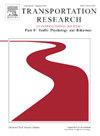哪些因素会加剧坠机后的焦虑和抑郁?一项基于扫描电镜的回顾性研究
IF 4.4
2区 工程技术
Q1 PSYCHOLOGY, APPLIED
Transportation Research Part F-Traffic Psychology and Behaviour
Pub Date : 2025-07-03
DOI:10.1016/j.trf.2025.06.027
引用次数: 0
摘要
交通事故是造成非自然死亡和重大经济和医疗负担的主要原因。在幸存者中,心理健康问题和生活质量下降一直与交通事故有关。几项研究表明,焦虑和抑郁症状在这些人中很常见。然而,调节这些崩溃后社会心理结果发展的具体个体因素,以及它们的相对贡献,在文献中几乎没有提到。因此,本研究的主要目的是检查不同因素对道路交通事故后两种主要消极自我报告心理结果(即焦虑和抑郁)的影响。这项调查对239名在车祸后遭受重大经济损失或非致命身体伤害的人进行了调查。在路径模型包含的全套研究变量中,碰撞严重程度对碰撞后焦虑严重程度得分有显著的正向影响。至于之前的焦虑和抑郁值,这些都受到回顾性报告的身体状况和坠机前焦虑和抑郁评分的显著影响。此外,崩溃前抑郁得分和崩溃后焦虑指数都是崩溃后抑郁指数的显著预测因子。这项研究表明,交通事故对自我报告的焦虑和抑郁相关结果有显著影响。在实际层面上,这些结果强调需要增加对坠机后心理健康结果的关注,因为它们在坠机幸存者中更为普遍,并且可能与进一步的损害行为或生活质量受损共病。本文章由计算机程序翻译,如有差异,请以英文原文为准。
What factors could enhance post-crash anxiety and depression outcomes? A SEM-based retrospective study
Traffic crashes are a leading cause of non-natural deaths and significant economic and healthcare burdens. Mental health issues and decreased life quality have been consistently linked to traffic crashes among surviving. Several studies reveal that anxiety and depression symptoms are common among these individuals. However, the specific individual factors modulating the development of these post-crash psychosocial outcomes, as well as their relative contributions, have been scarcely addressed in the literature. Thus, the primary objective of this study was to examine different factors’ effects on two key negative self-reported psychological outcomes (namely, anxiety and depression) following road crashes. The survey was conducted on 239 individuals who experienced substantial financial loss or non-fatal physical injuries after a crash. Among the full set of study variables comprised in the path model, crash severity has a positive and significant effect on post-crash anxiety severity scores. As for antecedent anxiety and depression values, these were significantly influenced by retrospectively-reported physical conditions and both pre-crash anxiety and depression scores. Moreover, both pre-crash depression scores and post-crash anxiety indexes stand out as significant predictors of post-crash depression indexes. This study suggests that traffic crashes have a significant effect on self-reported anxiety and depression-related outcomes. At a practical level, these outcomes underscore the need for increasing attention paid to post-crash mental health outcomes, given their considerably greater prevalence among crash survivors, as well as their possible comorbidity with further impairing behaviors or life quality impairments.
求助全文
通过发布文献求助,成功后即可免费获取论文全文。
去求助
来源期刊
CiteScore
7.60
自引率
14.60%
发文量
239
审稿时长
71 days
期刊介绍:
Transportation Research Part F: Traffic Psychology and Behaviour focuses on the behavioural and psychological aspects of traffic and transport. The aim of the journal is to enhance theory development, improve the quality of empirical studies and to stimulate the application of research findings in practice. TRF provides a focus and a means of communication for the considerable amount of research activities that are now being carried out in this field. The journal provides a forum for transportation researchers, psychologists, ergonomists, engineers and policy-makers with an interest in traffic and transport psychology.

 求助内容:
求助内容: 应助结果提醒方式:
应助结果提醒方式:


